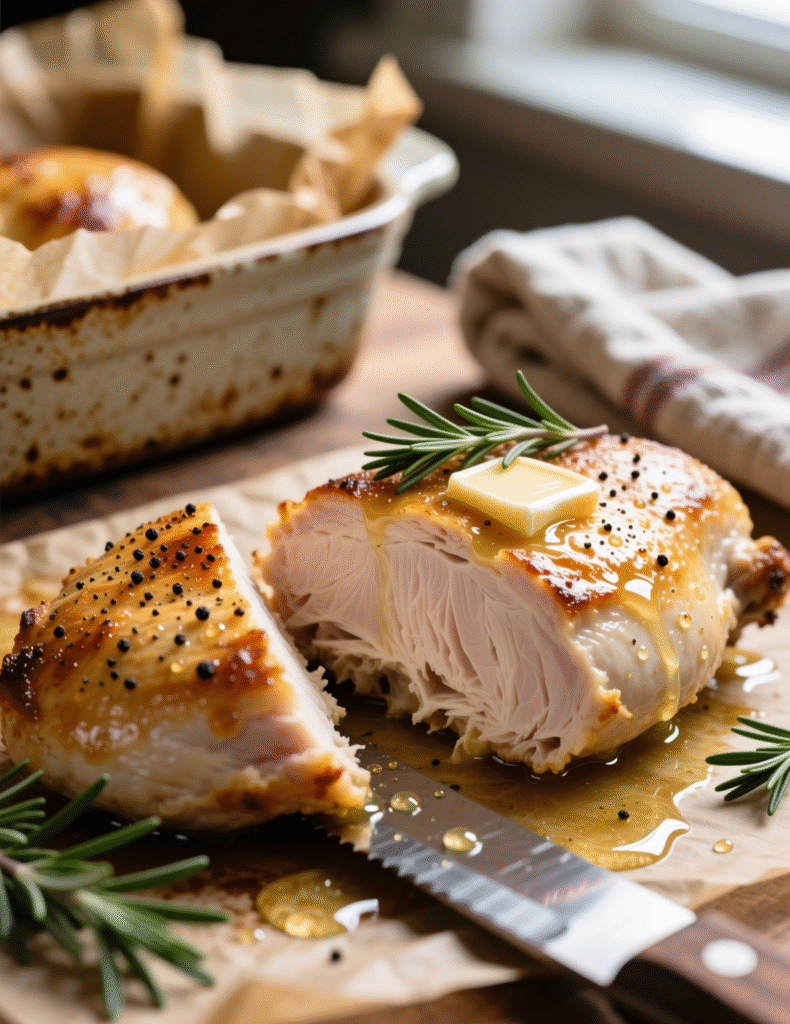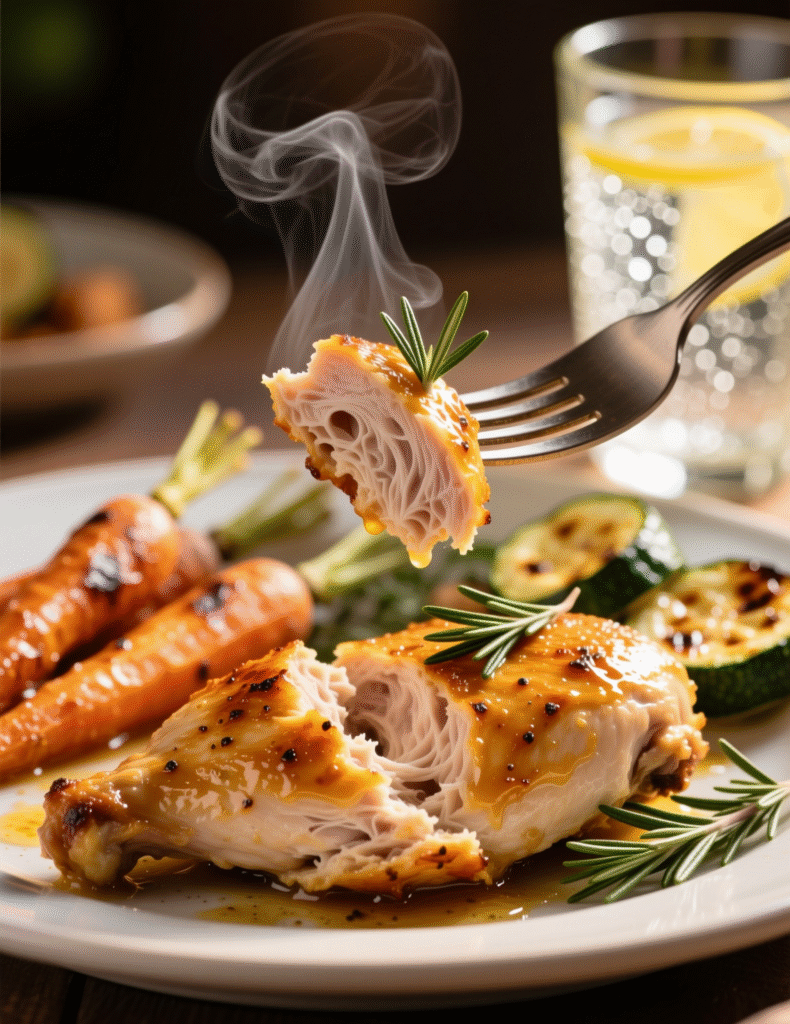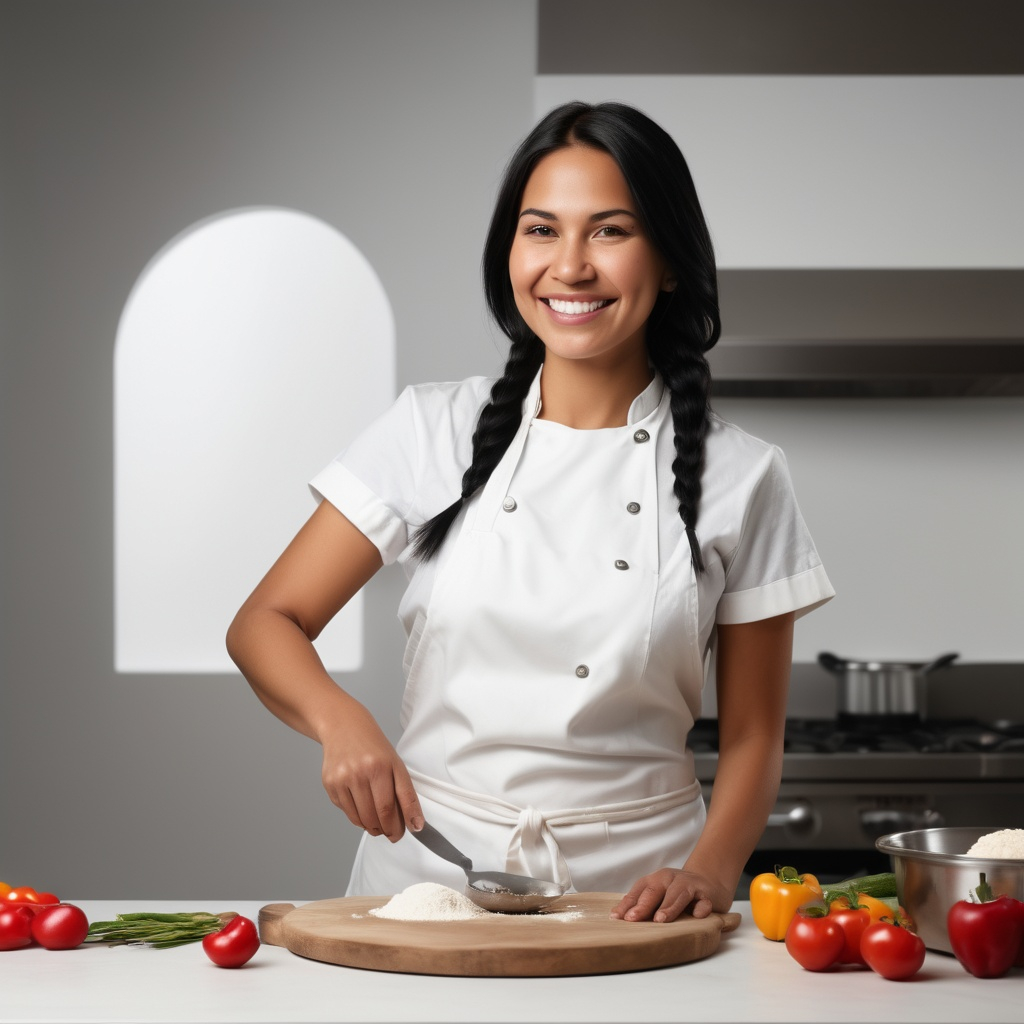There’s a reason oven baked chicken breast has a bad rep. Most folks overbake it till it’s dry as sandpaper, and then blame the bird. But truth be told, perfectly cooked oven baked chicken breast can rival any fried or grilled version when done right. Moist, flavorful, and beautifully golden — that’s what we’re aiming for here. This isn’t your average “throw it in and hope for the best” recipe. Nope, this one’s built for flavor precision and consistency.
The purpose of this guide is simple — to help you bake chicken breasts in the oven like a pro. Whether you’re running a restaurant kitchen or just cooking for four at home, mastering this simple recipe will change how you look at lean protein forever.
Why Oven Baked Chicken Breast Often Goes Wrong
Chicken breast is lean, yes, but that’s exactly why it’s tricky. With almost no fat to buffer against heat, it dries out in a blink. Many cooks bake it too long, skip the brine, or don’t let it rest properly. The result? A pale, tough piece of meat that tastes like disappointment.
The secret lies in temperature control and timing. You see, chicken is safe to eat at 165°F (74°C), but it continues to cook even after you pull it from the oven. That’s called carryover cooking — and it’s where most people go wrong. Professionals remove the chicken at 160°F, let it rest for 5–10 minutes, and the internal temp rises perfectly to 165°F. That’s where the magic happens.
Understanding the Science of Moisture Retention
Let’s talk science, just a bit. Chicken muscle fibers shrink when heated, squeezing out moisture. The faster they tighten, the drier your chicken gets. A gentle bake at 400°F (205°C) balances color and tenderness. High heat gives a crust, but steady heat keeps the juices where they belong — inside the meat.
A quick brine, even just 15 minutes in salted water, works wonders. The salt helps the muscle fibers hold onto moisture during cooking. If you skip the brine, don’t skip the resting stage. It’s non-negotiable. When you rest the chicken, those juices redistribute evenly, keeping every bite juicy instead of pooling out onto your cutting board.
Ingredients for the Perfect Oven Baked Chicken Breast (Serves 4)
- 4 boneless, skinless chicken breasts (about 6–7 oz each)
- 2 tablespoons olive oil
- 1 teaspoon kosher salt
- ½ teaspoon black pepper
- 1 teaspoon garlic powder
- 1 teaspoon smoked paprika
- ½ teaspoon onion powder
- 1 teaspoon dried Italian herbs (or fresh thyme if available)
- Optional: squeeze of lemon juice for brightness
That’s it — simple, clean flavors. The real craft comes in how you handle them.

Step-by-Step: How to Bake Chicken Breast Like a Pro
1. Preheat and prep.
Start by preheating your oven to 400°F (205°C). Line a baking sheet with parchment paper or foil. That ensures even heat and easy cleanup. Pat each chicken breast dry with paper towels — moisture on the surface prevents browning.
2. Pound to even thickness.
This might sound trivial, but it’s crucial. Uneven breasts cook unevenly. Gently pound the thicker end with a meat mallet or rolling pin until the piece is about ¾ inch thick all around. Consistency here means every breast finishes at the same time.
3. Season generously.
In a bowl, mix your olive oil with all the spices. Coat each piece thoroughly. Don’t skimp on seasoning — bland chicken is a culinary crime. Let it rest for 10–15 minutes at room temperature to let the flavors absorb slightly.
4. Bake, but don’t overbake.
Place the chicken breasts on your prepared tray, leaving space between each piece. Bake uncovered for 18–22 minutes, depending on size. Use a meat thermometer — it’s not optional. Pull them out when they hit 160°F internally.
5. Rest before slicing.
Place the baked breasts on a clean plate and loosely cover them with foil. Let them rest for 5–10 minutes. The carryover heat brings them to 165°F — juicy perfection. Slice against the grain before serving.
Expert Insight: The Power of the Brine
Here’s a trade secret chefs rarely skip — brining. Just dissolve ¼ cup of salt in 4 cups of lukewarm water, drop in the chicken, and let it sit for 15 to 30 minutes. Then rinse, pat dry, and season.
What this does is subtle yet dramatic. It changes the protein structure slightly so the meat holds more water. You’ll notice it the moment you cut into your chicken — less “fibrous chew,” more tender bite.
Some chefs even add sugar or herbs to the brine for added complexity. Personally, I prefer simplicity here. Salt alone does wonders.
Flavor Variations — For When You Want to Play Around
Once you’ve nailed the technique, the seasoning world opens up.
Lemon Herb Version
Use lemon zest, minced garlic, rosemary, and a touch of butter. It’s fragrant, fresh, and ideal for light dinners.
Honey Mustard Glaze
Whisk together honey, Dijon mustard, olive oil, and apple cider vinegar. Brush it on halfway through baking. You’ll get a sticky, golden coating with a sweet tang.
Spicy Cajun Kick
Use paprika, cayenne, garlic, and oregano. Great with roasted corn or creamy mashed potatoes.
Asian-Inspired Marinade
Combine soy sauce, sesame oil, ginger, and brown sugar. Marinate for 30 minutes before baking. It creates a rich umami flavor profile with caramelized edges.
Experimentation is how great chefs evolve a simple protein into a signature dish.
Common Mistakes and How to Avoid Them
Mistake #1: Baking straight from the fridge.
Cold meat lowers oven temperature unevenly. Always bring chicken to room temperature for about 15 minutes before baking.
Mistake #2: Over-seasoning with salt.
It’s tempting to go heavy-handed. But remember, salt is already part of the brine. Overdoing it makes your chicken too salty.
Mistake #3: Skipping the thermometer.
Eyeballing doesn’t work here. Chicken can look cooked and still be raw inside. Invest in a digital thermometer — it’s a small tool that changes everything.
Mistake #4: Slicing too soon.
Cutting into chicken immediately lets all the juices escape. Think of it like resting steak — patience equals payoff.
The Role of Marinades in Professional Kitchens
Marinating is not just about taste. It’s chemistry in a bowl. Acids (like lemon juice or vinegar) tenderize meat fibers, while oils carry fat-soluble flavors deep into the flesh.
Professional chefs often use vacuum sealers to speed up the marinating process. In home kitchens, a zip-top bag works fine — just press out as much air as possible. Even 30 minutes of marination makes a noticeable difference.
One pro tip: don’t over-marinate in acidic mixtures. It breaks down the proteins too much, making the texture mushy instead of tender.
Serving Ideas and Pairings
A well-baked chicken breast fits into almost any cuisine. You can slice it thin for sandwiches, dice it over salads, or serve it as the main course with roasted vegetables.
For balance, pair with something creamy or tangy. Try mashed potatoes, garlic rice, or a chilled couscous salad. Even a dollop of yogurt sauce or chimichurri elevates it to restaurant-level elegance.
A drizzle of pan sauce made from deglazing the baking sheet with a splash of white wine or chicken stock doesn’t hurt either. Scrape up those brown bits — that’s pure flavor gold.

Health Insights — Why Chicken Breast Reigns Supreme
A 4-ounce baked chicken breast contains around 165 calories, 31 grams of protein, and 3.5 grams of fat. It’s lean, nutrient-rich, and a top choice for fitness-focused diets.
Unlike red meats, chicken breast has minimal saturated fat and no carbohydrates. It’s also an excellent source of niacin and vitamin B6, which support metabolism and energy production.
When baked properly, it provides satiety without heaviness — a perfect canvas for meal prep, high-protein diets, and balanced eating.
Pro Chef Tricks to Boost Texture and Flavor
- Use compound butter. Mix softened butter with herbs, garlic, and lemon zest, then melt a small pat over hot chicken right after baking. Instant upgrade.
- Rest on a wire rack. This prevents the bottom from steaming in its own juices. Keeps the crust intact.
- Finish under the broiler. Two minutes under high heat gives it a golden, slightly crisp top without drying the inside.
- Use a cast iron pan. Retains and distributes heat evenly, ensuring consistent color and caramelization.
These micro-adjustments are what separate home cooking from professional execution.
Frequently Asked Questions
Can I bake frozen chicken breasts?
You can, but you’ll lose control over texture. Frozen chicken releases too much water, steaming instead of roasting. Always thaw first for best results.
Should I cover the chicken while baking?
No need. Covering traps steam and prevents browning. Bake uncovered for a lightly crisp exterior.
How do I store leftovers?
Cool completely, then store in an airtight container in the fridge for up to 3 days. Reheat gently at 300°F with a splash of broth to retain moisture.
Can I use bone-in breasts?
Yes, but increase cooking time to 30–35 minutes. Bone-in chicken retains heat longer and stays juicy.
How long should I bake chicken breasts at 400°F?
Bake for about 18–22 minutes, or until the internal temperature reaches 160°F before resting.
Should I cover the chicken while baking?
No, bake uncovered to get that golden, slightly crisp exterior.
Can I bake frozen chicken breasts?
It’s best to thaw them first for even cooking and better texture.
Why is my baked chicken always dry?
It’s likely overcooked—use a thermometer and rest the chicken after baking.
Do I need to brine the chicken before baking?
Yes, even a short 15-minute brine helps lock in moisture and tenderness.
Can I use bone-in chicken breasts for this recipe?
Yes, just extend the cooking time to about 30–35 minutes.
What’s the best way to store leftover baked chicken?
Keep it in an airtight container in the fridge for up to 3 days.
How do I reheat baked chicken without drying it out?
Warm it at 300°F with a splash of broth or water until heated through.
What internal temperature should cooked chicken breast reach?
It should hit 165°F for safe and juicy results.
Can I marinate the chicken instead of brining?
Absolutely, a 30-minute marinade adds flavor while keeping the meat tender.
Why should I let baked chicken rest before slicing?
Resting redistributes the juices, keeping every bite moist and flavorful.
Can I add sauce or glaze while baking?
Yes, brush it on during the last 5 minutes to avoid burning.
What oil is best for baking chicken breasts?
Olive oil works great—it adds flavor and helps with browning.
Can I make this recipe ahead of time?
Yes, bake and refrigerate, then gently reheat before serving.
What sides pair best with oven baked chicken breasts?
Try roasted vegetables, mashed potatoes, or a light salad for balance.
Emerging Trend: Precision Cooking Meets Simplicity
More chefs are integrating precision temperature control — using sous-vide techniques before finishing in the oven. This hybrid method ensures exact doneness every single time. The chicken is vacuum-sealed, cooked at 145°F in water for about 1 hour, then seared or broiled to develop flavor.
While it’s more equipment-heavy, it’s worth noting how restaurant kitchens are redefining “baked chicken.” It’s no longer just about convenience — it’s about achieving repeatable excellence.
Final Thoughts
A well-baked chicken breast is a quiet triumph. It doesn’t shout for attention but rewards precision, timing, and respect for ingredients. Whether you’re meal prepping for the week or plating for paying guests, this recipe offers something consistent — dependably juicy results and deep, honest flavor.
If there’s one takeaway, it’s this: treat lean meat gently. Use your thermometer, trust the rest time, and season with intention. Get that right, and oven baked chicken breast will go from a weeknight standby to a signature dish worth repeating.
A simple recipe, sure — but in the hands of a mindful cook, it’s pure craft.

Marie Smith is a passionate recipe blogger, sharing easy, delicious, and creative culinary ideas that inspire home cooks to elevate everyday meals with flavor and simplicity.
